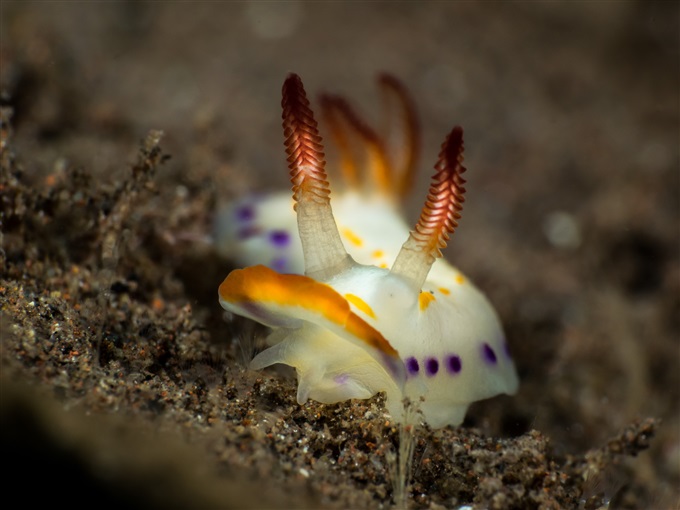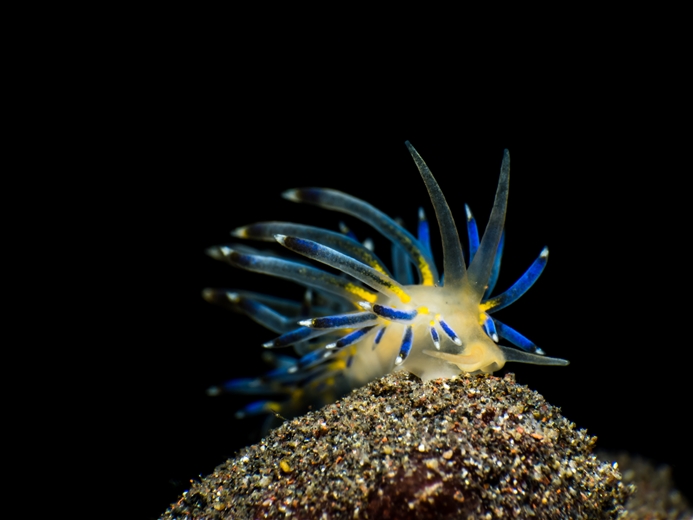My fascination with Bali will never end. So, here is another story about one of my favourite dive spots. During the first blog posts we focused on Bali’s healthy corals and overgrown wrecks. This time we are going to stick our nose in the sand and get to know some of the most colorful and fascinating creatures of the underwater world – the nudibranchs.
So what is a nudibranch?
The fondly called “nudi” belongs to the family of mollusks. The name comes from latin nudibranchia whereby nudi- refers to “naked”, and -branchia to “gills”. So, nudibranchs are basically naked, or unprotected, gills since these mollusks lack a protective shell. You find nudibranchs in all oceans of the planet, and they come in all colors and sizes from a fraction of a millimeter up to half a meter!

Ann Karin Matberg • OM-D E-M1 • M.ZUIKO DIGITAL ED 60mm 1:2.8 MACRO
• PT-EP11 • PPO-EP01 • 2 x UFL-3
The different species of nudies are often described by color, the two tentacles on the head (the rhinophores), the gills and the cerata ( “tentacles”) on their back. The rhinophores are sensory organs that register smell and taste, and vibrations and even water pressure, while the cerata have a different purpose as described below. Even though all nudies have eyes, they are often hidden, and will just register light and shadow. Since most nudibranchs do not have visible eyes, at least you want the rhinophores to appear sharp in the picture. So, focus on the rhinophores when taking pictures of nudis!
All nudis are predators and feed on sponges, cnidarians (for example corals), bryozoans and ascidians. Since they do not have a shell to hide under or inside, they have developed sophisticated ways of defending themselves. Some are relying on camouflage and literally melt into their surroundings living according to the motto “If you can’t see me, you can’t eat me”. Others are fighting a chemical war. They can, for instance, feed on cnidarians that are equipped with stinging cells. Instead of the nudibranch dying or getting hurt from these stingers, they simply swallow and incorporate them into their own body to use them as a defense against predators. The white tips you see on this blue cerata are the stinging cells it has eaten earlier on! Awesome!
Some nudis have even created their own solar powered factory inside their own body. They do this by feeding on algae with chloroplasts, and then store the chloroplasts within their body. Just like with plants above the water, the chloroplasts inside the nudi will transform sunlight into energy that feeds it. Nature is full of magnificent solutions!

Ann Karin Matberg • OM-D E-M1 • M.ZUIKO DIGITAL ED 60mm 1:2.8 MACRO
• PT-EP11 • PPO-EP01 • 2 x UFL-3
As found quite often in the animal world, strong colors signalize “I’m poisonous, please consider if you really want to have me as a snack”, and nudibranchs are no different in this matter. This might be the reason for the incredible variety in color we find amongst the nudis. The often stunning colors are a reason why so many divers find nudibranchs their favorite subject. Some are taking a more passionate interest in this than others, and I had the pleasure of joining a nudibranchsafari in Bali last February.
Safari makes me think of savannas, African trees, giraffes and lions. Little had I known that my first safari would be spent underwater searching for tiny nudis on a sandy bottom that seemed completely abandoned of life. But does gray, sandy, seemingly deserted bottom equal dead bottom?
If you saw the teaser movie posted in “Bali – wrecks and corals, part II” - you got your answer!

Ann Karin Matberg • OM-D E-M1 • M.ZUIKO DIGITAL ED 8 mm 1:1.8 Fisheye PRO
• PT-EP11 • PPO-EP02 • 2 x UFL-3
Again and again, the variety, the looks, the colors and the beauty of these creatures fascinate me. Marine biologist Klas Malmberg, biologist Kennet Lundin, and Per Lagerberg, owner of PH Travel & Dive, all from Sweden, were hosting the nudi-safari. When they set the goal that we should – during only ten days of diving in the Tulamben-area of Bali – try to find 200 different species of nudis, I honestly thought they were out of their minds. It sounded impossible. Boy, how wrong I was! During the safari, we took pictures and positively identified no less than 366 species on the spot!
Since cold waters also have nudibranchs, you don’t have to travel to far off destinations to be mesmerized by these beautiful animals. Just get underwater wherever you are in the world, and you don’´t have to go deep – you find them from just under the surface to deeper than a recreational diver should go.
Comments